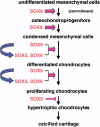The transcription factor Sox9 has essential roles in successive steps of the chondrocyte differentiation pathway and is required for expression of Sox5 and Sox6
- PMID: 12414734
- PMCID: PMC187468
- DOI: 10.1101/gad.1017802
The transcription factor Sox9 has essential roles in successive steps of the chondrocyte differentiation pathway and is required for expression of Sox5 and Sox6
Abstract
To examine whether the transcription factor Sox9 has an essential role during the sequential steps of chondrocyte differentiation, we have used the Cre/loxP recombination system to generate mouse embryos in which either Sox9 is missing from undifferentiated mesenchymal cells of limb buds or the Sox9 gene is inactivated after chondrogenic mesenchymal condensations. Inactivation of Sox9 in limb buds before mesenchymal condensations resulted in a complete absence of both cartilage and bone, but markers for the different axes of limb development showed a normal pattern of expression. Apoptotic domains within the developing limbs were expanded, suggesting that Sox9 suppresses apoptosis. Expression of Sox5 and Sox6, two other Sox genes involved in chondrogenesis, was no longer detected. Moreover, expression of Runx2, a transcription factor needed for osteoblast differentiation, was also abolished. Embryos, in which Sox9 was deleted after mesenchymal condensations, exhibited a severe generalized chondrodysplasia, similar to that in Sox5; Sox6 double-null mutant mice. Most cells were arrested as condensed mesenchymal cells and did not undergo overt differentiation into chondrocytes. Furthermore, chondrocyte proliferation was severely inhibited and joint formation was defective. Although Indian hedgehog, Patched1, parathyroid hormone-related peptide (Pthrp), and Pth/Pthrp receptor were expressed, their expression was down-regulated. Our experiments further suggested that Sox9 is also needed to prevent conversion of proliferating chondrocytes into hypertrophic chondrocytes. We conclude that Sox9 is required during sequential steps of the chondrocyte differentiation pathway.
Figures










References
-
- Ahdjoudj S, Lasmoles F, Oyajobi BO, Lomri A, Delannoy P, Marie PJ. Reciprocal control of osteoblast/chondroblast and osteoblast/adipocyte differentiation of multipotential clonal human marrow stromal F/STRO-1(+) cells. J Cell Biochem. 2001;81:23–38. - PubMed
-
- Akiyama H, Hiraki Y, Shigeno C, Kohno H, Shukunami C, Tsuboyama T, Kasai R, Suzuki F, Konishi J, Nakamura T. 1 α,25-dihydroxyvitamin D3 inhibits cell growth and chondrogenesis of a clonal mouse EC cell line, ATDC5. J Bone Miner Res. 1996;11:22–28. - PubMed
-
- Albrecht U, Eichele G, Helms JA, Lu HC. Visualization of gene expression patterns by in situ hybridization. In: Daston GP, editor. Molecular and cellular methods in developmental toxicology. Boca Raton, FL: CRC Press; 1997. pp. 23–48.
-
- Bell DM, Leung KK, Wheatley SC, Ng LJ, Zhou S, Ling KW, Sham MH, Koopman P, Tam PP, Cheah KS. SOX9 directly regulates the type-II collagen gene. Nat Genet. 1997;16:174–178. - PubMed
-
- Bi W, Deng JM, Zhang Z, Behringer RR, de Crombrugghe B. Sox9 is required for cartilage formation. Nat Genet. 1999;22:85–89. - PubMed
Publication types
MeSH terms
Substances
Grants and funding
LinkOut - more resources
Full Text Sources
Other Literature Sources
Molecular Biology Databases
Research Materials
Miscellaneous
